CLAS Faculty Receive Teaching Excellence Awards
For their exceptional teaching and student engagement, Michael Walter, Alan Rauch, Tiffany Morin and Katie Kutcher have received the College of Liberal Arts & Sciences’ 2022 Excellence in Teaching Awards.
Walter, an associate professor of chemistry, and Rauch, a professor of English, each received the Integration of Undergraduate Teaching and Research Award, the first time that two faculty members were chosen for the honor. Morin, a faculty member in the Department of English, received the Award for Outstanding Teaching by a Full-Time Lecturer. Kutcher, a faculty member in the Gerontology Program, earned the Award for Outstanding Teaching by a Part-Time Faculty Member.
The award recipients were recognized at an awards ceremony and reception in the Halton Reading Room in J. Murrey Atkins Library. In addition to the award recipients, finalists who were honored were:
- Crystal Eddins, Africana Studies, and Paola Lopez-Duarte, Biological Sciences: Integration of Undergraduate Teaching and Research Award.
- Kathleen Burke, Psychological Science, and Samantha Furr, Biological Sciences: Outstanding Teaching by a Full-Time Lecturer.
- Leah Walton, History: Outstanding Teaching by a Part-Time Faculty Member.
Alan Rauch, English
Alan Rauch has taught in the Department of English since 2002. As a trained scientist with a bachelor’s degree in biology and master’s degree in zoology, and a literary scholar with master’s and doctoral degrees in literature, Rauch has built an innovative research portfolio. He has long been interested in the intersections between science and the humanities, and his research and teaching showcase the dimensions of both.
In one course, ‘Animals, Culture and Society,’ Rauch used the UNC Charlotte Botanical Gardens to teach about ecology, environmentalism, and zoology, to give students a fuller understanding “of not only what animals mean to humans and how humans respond to animals, but to address the ‘posthuman condition.’ ”
One student wrote, “I first met Dr. Rauch when I took his animals class my freshman year where I grew an interest in animal toxicity and began to develop chemical questions about animal interactions. I have had the opportunity to expand on these interests with Dr. Rauch through an independent study focusing on the chemical evolution of plant-animal toxicity relationships. As a chemistry major, my study focus has been on the technical aspects of my science and has neglected my philosophically driven questions which led me to pursue science in the first place. With Dr. Rauch I am able to make these connections, which has been a unique and fulfilling experience.”
Rauch’s teaching practice connects to his research, the development of curiosity, and rigorous interrogation. The same dynamic is present in his mentoring of students, including through the Office of Undergraduate Research Summer Research Scholars program. He also works with students on publications, such as one student’s detailed study of sloths in popular culture that will be included in Rauch’s forthcoming book, “Sloth.”
Michael Walter, Chemistry
Michael Walter joined the faculty at UNC Charlotte in 2011. Since then, he has secured over $2.5 million in external grant funding and published two dozen papers. He is the inventor of co-inventor for three patents, one of the patents is licensed to a local company.
His research program, and his real-world teaching illustrations, are built around the study of various materials that use light interactions for energy. Students learn how powerful organic chemistry photochemical tools can be used to address scientific challenges.
Undergraduate students are attracted to Walter’s research laboratory as early as their sophomore year as a result of their experiences in his classes. He has mentored 53 students from a variety of majors, including chemistry, biology, physics, public health, and mathematics.
His interactions with undergraduate students have resulted in over 50 research talks and posters with several invited talks, all presented by the students.
He developed an “e-molecules” activity where students research the structure of widely used organic molecules that might be used in pharmaceuticals or other materials. The course also includes a hands-on photochemistry activity, called “Juice-from-Juice” where students build blackberry juice, dye-sensitized solar cells. The activity is a powerful example of how an organic molecule extracted from blackberry juice can be used to harness sunlight and convert it to usable electricity and power.
A new activity in his classes looks at the connections among the luminescent materials encountered in daily lives, from organic light-emitting diodes (OLEDs) in cell phone screens to the bioluminescence from fireflies seen on a summer night.
He has also worked with undergraduate students from the College of Arts + Architecture on an award-winning collaborative solar energy project.
Tiffany Morin, English
Tiffany Morin has been a lecturer in the Department of English since 2018, after serving as an adjunct lecturer in the department from 2008 to 2018. She has been coordinator of the English Learning Community since 2012. She earned a master’s degree from UNC Charlotte in English Literature in 2008.
The awards committee pointed to Morin’s commitment to engagement and student transformation. Morin publishes and presents talks on themes of villains and horror in children’s literature, with a particular focus on the role of vampires in this imaginary.
Her classes similarly engage students in in-depth and critical thinking about the role of evil, villains, and monsters in literature and daily life. Her classes range from first-year seminars to upper-level English courses and use a variety of innovative teaching and learning techniques, such as an Alice in Wonderland tea party and poetry reading, trips to the Charlotte Ballet and Carolina Renaissance Festival, guest lectures and class visits by authors, and robust debates about the nature of good and evil.
Morin has developed her teaching techniques through a variety of teaching experiences, seminars, and workshops. She now holds “open swim” Zoom hours to help other faculty develop online teaching skills. She advises on library engagement, and presents best practices for engaged learning in student learning communities.
Students in her courses describe “life-changing experiences” and emphasize how Morin’s classes not only teach content but also broader life skills. One student said, “I could see myself grow more and more passionate and excited about my English studies and I can honestly say I feel extremely encouraged and confident about the path I’m on. I have never felt more comfortable in a school setting before.”
Another student said, “I’ve got a lot more out of this class than I ever expected to – actual personal growth – which is crazy considering that this is an online class on monster films.”
Kate Kutcher, Gerontology
Katie Kutcher earned a master’s degree in gerontology from UNC Charlotte in 2011 and added a certificate in non-profit management from Duke University in 2016.
With her full-time employment as an aging programs coordinator with the Centralina Area Agency on Aging, she supervises and supports staff in nutrition, senior centers, transportation and evidence-based health programs. The awards committee described Kutcher as an innovative teacher focused on helping students make real-world connections.
Kutcher has taught classes at UNC Charlotte for the last five years, including courses focused on aging and dementia at the undergraduate and graduate level. In her classes, she connects content with life skills including time management and personal reflection around aging, and engages students with community partners through service-learning opportunities. She also emphasizes her classroom as a safe space where students’ opinions and input are valued, including students in syllabus and classroom guideline creation at the start of each semester.
One student said, “I feel like Professor Kutcher really helped me and cared for my classmates (and me) and was always respectful and professional.”
A community partner described the impact of one of her engaged learning activities. “The rapid and continual development of technology, combined with the COVID pandemic, has seemed to leave seniors more and more alienated from much of the world, and this conversation program is a great way to keep them involved and feel valued,” the partner said. “I want to thank you and all of the students for this from the bottom of my heart!”
Awards Committees
Integration of Undergraduate Teaching and Research selection committee members were: committee Chair Didier Dreau, Biological Sciences Department; Kirill Afonin, Chemistry Department; and Matthew Rowney, English Department.
Selection committee members for the part-time and full-time teaching awards were committee Chair Sara Juengst, Anthropology Department; Benita Staples, Geography and Earth Sciences Department; and Sarah Wells, Chemistry Department.
Top Image: Dean Nancy Gutierrez (left to right), Alan Rauch, Katie Kutcher, Tiffany Morin, Michael Walter
UNC Charlotte Botanical Gardens Retired Director Larry Mellichamp Joins Rare Group With Flora Caroliniana Award
Longtime UNC Charlotte Botanical Gardens Director Larry Mellichamp ’70, who retired in 2014 after almost four decades directing the gardens, is the seventh person ever to receive the prestigious Flora Caroliniana Award from the North Carolina Botanical Garden.
The award recognizes enthusiasm and service to the preservation, restoration, and appreciation of the natural world. Surrounded by family, friends and colleagues, Mellichamp received the award in late April at a ceremony in the UNC Charlotte Botanical Gardens’ Mellichamp Native Terrace.
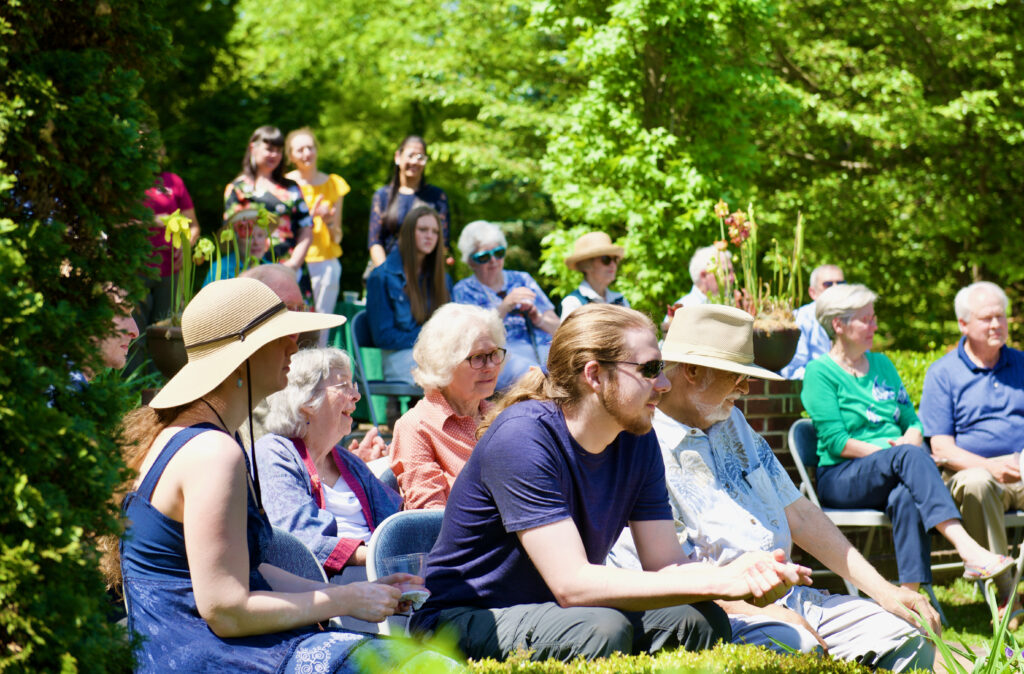
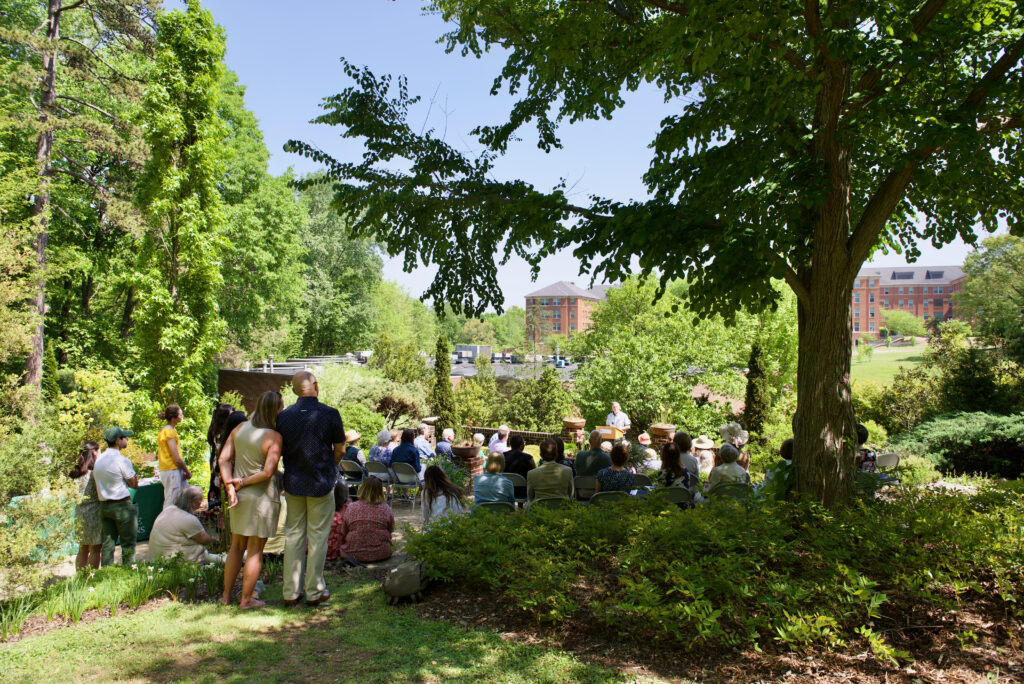
People perched on rock walls, folding chairs and grassy knolls, settling into the sun-dappled space named for Mellichamp and designed to help people learn to use his beloved native plants in home landscapes. Birds swooped overhead, adding their notes to the words offered by colleagues, friends and contemporaries in the botanical field.
“I had the honor and adventure of working with Larry for 18 years here at the UNC Charlotte Botanical Gardens, and co-authoring two books together,” said Paula Gross, retired associate director, in a moving tribute. “I’m so pleased to be standing here in a garden co-created with Larry, Ed Davis, Johnny Massengale, and the entire staff, donors, and volunteer community of the Botanical Gardens. A place nourishing to body, mind, and spirit, bearing a very special name – Mellichamp.”
An expert on native wildflowers, trees, shrubs, and carnivorous plants, particularly Sarracenia pitcher plants, Mellichamp is professor emeritus in the Department of Biology. He earned a bachelor’s degree in biology at UNC Charlotte in 1970 and a doctoral degree in botany from the University of Michigan before joining the University as faculty in 1976.
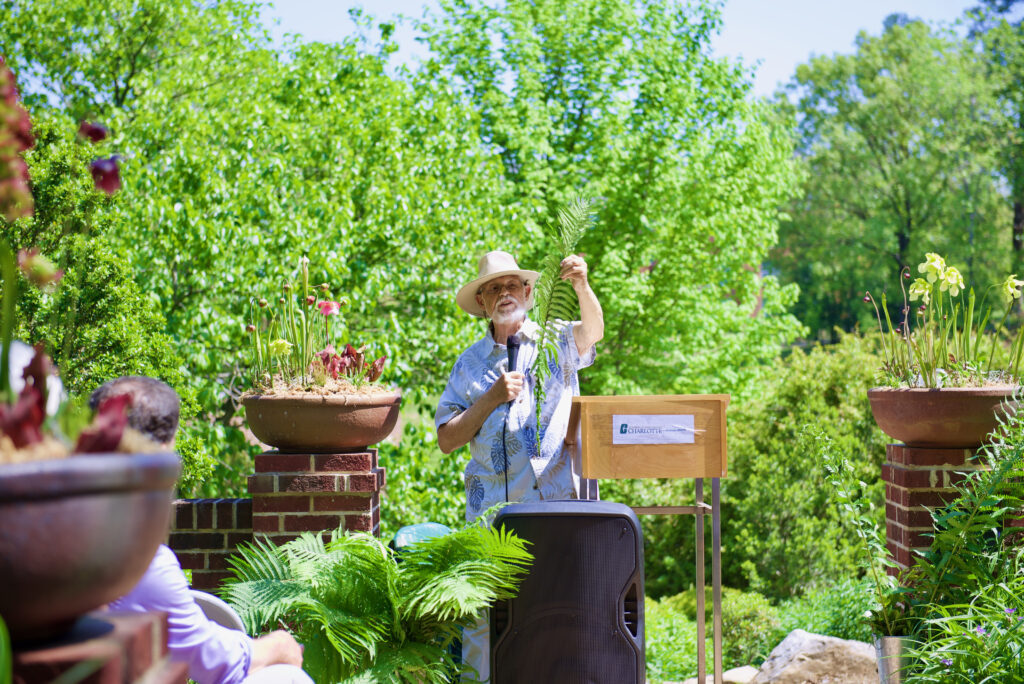
He has written technical and layperson articles on plants and gardening, given hundreds of talks, taught thousands of students and community members, and written or co-authored six books that serve novice and advanced gardeners, including perhaps the best known, “Native Plants of the Southeast.”
The award was presented to Mellichamp by Johnny Randall, NCBG director of conservation programs, and Alan Weakley, director of the UNC Herbarium. Previous Flora Caroliniana Award recipients are:
- Lady Bird Johnson for advocating for native plants and helping the North Carolina Botanical Garden launch its first fundraising campaign, “Celebrating Wildflowers.” (1988)
- John Terres, naturalist and author best known for his work, From Laurel Hill to Siler’s Bog: The Walking Adventures of a Naturalist. (1991)
- William Lanier Hunt to honor him as the Founder of the Botanical Garden Foundation. (1996)
- Ritchie Bell the North Carolina Botanical Garden’s first director from 1961 to 1986. (2000)
- Thomas Wright Earnhardt in recognition of his lifelong contributions to conservation. (2016)
- Charlotte Jones Roe in honor of 44 years of service, tirelessly advocating for the North Carolina Botanical Garden. (2018)
Words and images: Lynn Roberson | Top Image: Larry Mellichamp (center) with Johnny Randall, North Carolina Botanical Garden, and Alan Weakley, UNC Herbarium
New Insight Into Coral-Algae Symbiosis Aims To Help Reefs Recover From Mass Bleaching
Corals are keystone species for reef and marine ecosystems, but coral bleaching due to climate change and ocean warming is killing them. A new open access study led by researchers at UNC Charlotte and the University of California, Riverside aims to shed light on how to reverse the damage and save corals.
Corals, together with sea anemones and jellyfish, belong to a group of animals called cnidarians that receive some of their nutrients through a symbiotic relationship with photosynthetic algae living inside their cells. High ocean temperatures cause a breakdown in the symbiosis, resulting in a ‘bleached’ coral that has expelled the algae. If symbiosis is not initiated within a few weeks, the coral starves to death.
The new study finds that although photosynthesis by algae is a key part of the symbiotic relationship, it is not required to initiate symbiosis.
Tingting Xiang, an assistant professor of biological sciences at UNC Charlotte, and Robert Jinkerson, an assistant professor of chemical and environmental engineering at UCR, led the research team. The open-access paper, “Cnidarian-Symbiodiniaceae symbiosis establishment is independent of photosynthesis,” is published in Current Biology.
Jump-starting a Relationship
The study adds to the little-understood relationship between cnidarians and algae at the molecular level and offers insight into how to jump start the symbiotic relationship between the two organisms after a bleaching event. It could also lead to strategies that might prevent warmer oceans from breaking the symbiotic relationship between the two organisms and saving what remains of the world’s corals.
Cnidarians form a mutualistic symbiosis with photosynthetic algae from the dinoflagellate family Symbiodiniaceae that live inside their host cells. The algae perform photosynthesis, fix carbon dioxide into sugars, and then give that to their hosts. Some species of coral are completely dependent on the food they receive from their algal symbionts and will die without it.
In return, the algae receive nutrients like nitrogen and phosphorus from the prey that the host catches. Photosynthesis is a key part of this symbiotic relationship, but it was not known if this symbiosis can form without photosynthesis.
Symbiosis establishment can proceed without photosynthesis in coral, jellyfish, and sea anemone hosts, but different aspects of the relationship, such as proliferation of the algae without photosynthesis, depends on the specific host–algae relationship.
Focus Looks at Saving Corals
“Our study highlights the power of forward genetic approaches to probe cnidarian Symbiodiniaceae symbiosis and provides a promising platform to answer key questions in symbiosis and ultimately develop strategies to save corals,” Xiang said.
The research team made the first mutants in Symbiodiniaceae algae – isolate mutants that lack the ability to photosynthesize – and used these mutants to investigate symbiosis with cnidarians.
“We were very excited to be able to generate six photosynthetic mutants and then use those mutants to start to probe the symbiosis between these algae and their hosts,” Jinkerson said.
The team introduced the mutant algae into seawater tanks that contained sea anemones (Exaiptasia pallida) that had not yet established symbiosis with any algae. After just one day the algae could already be found within the sea anemone’s tentacles, even without photosynthesis.
To learn if the algae could survive in sea anemone host tissue without photosynthesis for longer periods of time, the researchers infected some sea anemones in darkness with mutant and non-mutant algae and kept them in darkness for six months. Even after six months, algal cells were still observable in the sea anemone’s tissues. Although able to infect the host cells and maintain itself for six months, the algae did not reproduce and proliferate in number.
The research group also tested four other species of algae known to form symbiotic relationships with the sea anemones and found that they too could initiate symbiosis in the dark.
Xiang, Jinkerson and their colleague Masayuki Hatta in Japan then introduced the algae in darkness into a tank containing juvenile polyps of a stony coral, Acropora tenuis. The algae infected the coral successfully in the dark. Unexpectedly, the algae were able to proliferate in the coral tissues without photosynthesis, something not observed in the sea anemones.
Finally, to learn if the pattern held true for the third member of the cnidarian group, the researchers added the algae to a darkened tank of upside-down jellyfish (Cassiopea xamachana) polyps. Once again, the algae infected the polyps, though not as successfully as in the sea anemone and coral.

The discovery that photosynthesis is not essential to begin symbiotic relationships is a step toward finding ways to help cnidarians survive climate change, with time being of the essence in protecting coral reefs.
The latest findings offer additional research opportunities as Xiang works closely with students in her lab, who will contribute to advancements in the research, she said.
“I also am sharing this research in coral-algal symbiosis with the students in my classes in an effort to pass along the enthusiasm we feel for the research, along with our knowledge and expertise,” she said.
Xiang is also affiliated with UNC Charlotte’s Center for Computational Intelligence to Predict Health and Environmental Risks (CIPHER). CIPHER focuses on computational and empirical research to counter the spread of current and emerging infectious diseases and addresses some of the most vexing societal challenges, including antibiotic resistance, food safety and ecosystem health.
Jinkerson, Xiang, and Hatta were joined in the research by Casandra R. Newkirk, a postdoctoral researcher in Xiang’s lab, and UNC Charlotte Assistant Professor of Biological Sciences Richard Chi, along with Joseph Russo, Andrea L. Kirk, Mark Q. Martindale, and Arthur R. Grossman.
Words: Courtesy of the University of California, Riverside with added content by UNC Charlotte’s College of Liberal Arts & Sciences | Images: Courtesy of the study authors
Nanotechnology Particles From UNC Charlotte Lab Featured on Cover of Federal Document
The National Cancer Institute (NCI) is showcasing nanotechnology particles designed and produced by leading UNC Charlotte researcher Kirill Afonin’s lab on the cover of a document presented to the U.S. House and Senate appropriations committees. NCI is the principal federal agency for cancer research and training.
Each year, when the president submits an annual budget, each executive agency prepares a document called the “congressional justification.” Each agency’s document explains its mission, outlines goals and objectives for the next fiscal year, and gives data and analysis of the budget request and past years’ budgets.
This year’s NCI document features an image of nanotechnology particles in a culture of blood cells developed by a team led by Afonin, a professor in the Department of Chemistry. The team developed the nano particles as part of its research on vaccine adjuvants, substances that enhance the body’s ability to produce an immune response.
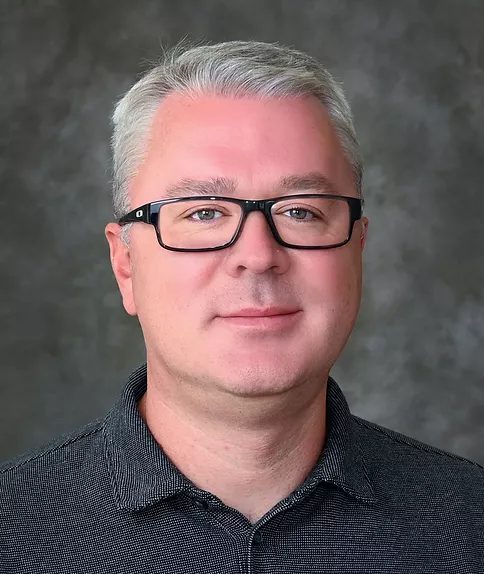
Afonin and his team have collaborated closely with the NCI Nanotechnology Characterization Laboratory (NCL) at the Frederick National Laboratory for Cancer Research. The lab helps cancer researchers study nanotechnology particles and characterize them by measuring their physical and chemical properties. The research seeks applications including cancer vaccines, other cancer therapeutics, and diagnostics.
The Afonin lab’s mission is to “develop novel functional RNA-based nanomaterials that can either communicate with each other or with cellular machinery, or be readily responsive to various stimuli.” The research seeks to improve the operation of current therapeutic systems and to engineer novel “smart” biomaterials.
Established under the National Cancer Institute Act of 1937, NCI is part of the National Institutes of Health (NIH), one of 11 agencies that make up the Department of Health and Human Services.
CLAS Graduate Programs Ranked Among Best In Nation by U.S. News and World Report
UNC Charlotte has been recognized for some of the best graduate programs in the nation by U.S. News and World Report, including the MPA program and statistics track in the Applied Math Ph.D. in the College of Liberal Arts & Sciences. In total, 11 programs were among the top 100 in the country by the publication.
Charlotte’s Master of Public Administration (MPA) ranks second among all UNC System universities’ public affairs programs, third among all programs ranked in North Carolina and in the top 18% of all ranked programs nationally, with its ranking of #49. The Gerald G. Fox MPA program includes concentrations in local government management (ranked No. 22) and nonprofit management (ranked No. 32).
Other graduate programs earning national rankings included statistics in the Applied Math Ph.D. program in the College of Liberal Arts & Sciences. The program was ranked #70, moving up from #97 in 2018, the last time statistics programs were ranked.
“Our faculty are among the best in the nation,” said Provost Joan F. Lorden. “They are committed to providing academic programs grounded in research, scholarship, creative discovery and entrepreneurship that equip their students with both a firm theoretical foundation and a practical application of their knowledge and skills. Being recognized year over year by U.S. News and World Report is affirmation of the strength of a graduate education at Charlotte.”
Interdisciplinary Mathematical Finance Graduate Program Climbs To Its Highest Ranking In 2022 TFE Times List
UNC Charlotte’s Master of Science in Mathematical Finance program has soared to its highest national ranking ever. The program is No. 11 in the TFE Times’ 2022 Master of Financial Engineering program rankings.
Over the past six years, the M.S. in Math Finance program has increased steadily in the rankings, rising nine slots since 2016.
“UNC Charlotte’s M.S. in Mathematical Finance is proud to be a leader among financial engineering programs in the country,” said Dr. Yufeng Han, M.S. in Math Finance program director. “This ranking places us among elite institutions and demonstrates the quality of our quantitative graduate programs.”
The growth of the program’s success is a testament to the exceptional faculty, combined with a customizable interdisciplinary approach, Han said.
As the second-largest financial center in the United States, Charlotte relies on UNC Charlotte to supply talent and insights — new financial technology — that drives the region’s economy. As a STEM-designated program of the departments of Finance and Economics in the Belk College of Business and the Department of Mathematics and Statistics in the College of Liberal Arts & Sciences, the program excels as an emerging field in one of the top AACSB accredited business schools in North Carolina.
The program gives students strong preparation for careers in finance, including an emphasis on growing their math and data skills, said Taufiquar Khan, chair of the Department of Mathematics and Statistics.
“Students apply highly sophisticated mathematical models to identify, measure, and manage risk, preparing them for real-world situations they will face,” Khan said. “The mathematical finance program draws upon the expertise of diverse faculty in economics, finance and mathematics. This interdisciplinary approach yields strong outcomes for students and for employers.”
The TFE Times rankings are among the most comprehensive for graduate financial engineering, financial mathematics, quantitative finance, computational finance and mathematical finance programs in the country. The rankings are calculated based on several components, including average test scores, starting salaries, undergraduate GPA, acceptance rates and graduate employment rates.
Prof. M. Yasin Raja Promoted as SPIE Fellow
Congratulations to Dr. Raja for being promoted as a SPIE fellow.
Brent Johnson (SPIE Member Recognition Coordinator) sent a congratulatory email message on behalf of the SPIE Board of Directors and Fellows Committee on Dec. 22nd, 2021 that Dr. M. Yasin Akhtar Raja has been elected to the grade of Fellow of SPIE among 58 professionals for the year 2022. The new fellows will be recognized in one of the SPIE’s 7 upcoming meetings/communities (of fellow’s choice) from Photonics West to Optics+Photonics. Prof. Raja is planning to attend Optics+Photonics scheduled on 21-25, August’ 2022 in the Convention Center San Diego, CA.
Link for 2022 SPIE Fellow: https://spie.org/membership/explore-membership/fellows
Scott Williams recognized by Laser and Photonics Lab, Central Carolina Community College
Scott Williams has been recognized by the Laser and Photonics labs of Central Carolina Community College (CCCC) for being a founding CCCC laser program advisor, thus providing valuable advice and direction during the first meeting which set the stage for changing the focus of study for the laser program from fiber optics laser applications to other laser applications.
Congratulations, Scott!
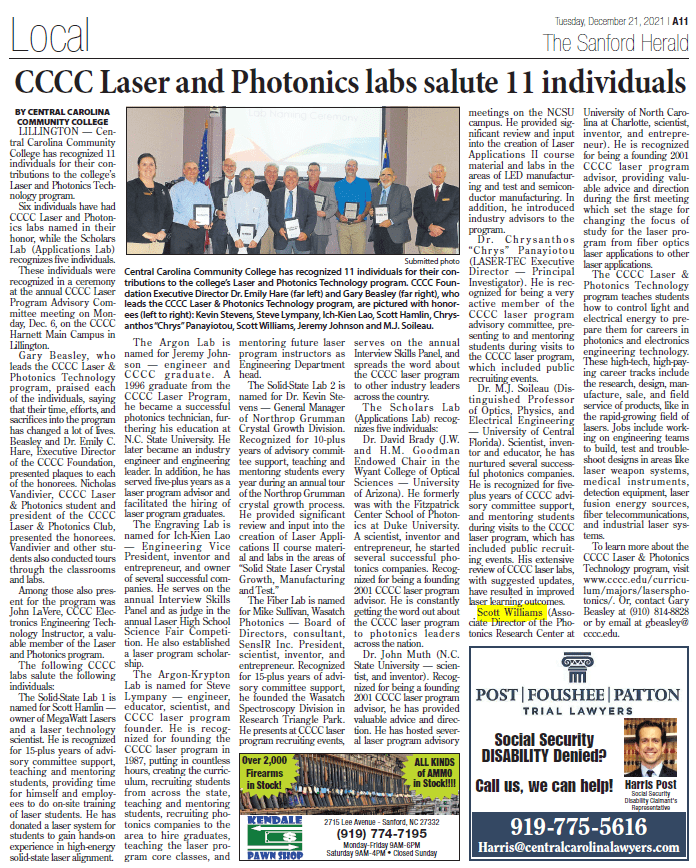
UNC Charlotte Biochemist’s Research Holds Promise For Novel Treatments for Cancers and Neurological Diseases, Shaping Global Work On “The Chaperone Code”
For UNC Charlotte biochemist Andrew Truman, a quest for new and better treatments for cancers and neurological diseases drives his research into protein folding and the DNA damage response, along with his desire to advance science broadly. To fund his work, he has received three significant National Institutes of Health (NIH) grants expected to total $2M.
“These are real things that affect real people. They are not theoretical.”
— Andrew Truman
“Working in our labs, we are curious to understand how cells function,” Truman says. “But there are people all over the world affected by these illnesses. We are very privileged to have funding from the NIH to drive this research forward.”
Decrypting The Chaperone Code
When proteins are created in cells, they resemble unwound balls of string. The strands must be wound and folded into specific shapes for proteins to become active. Unraveling the mysteries of these complex processes – and how they influence the development and potential treatment of diseases – shapes the research.
“This winding and folding function is performed by what are known as chaperone proteins. These proteins are present – and nearly identical – in all organisms from bacteria to yeast, frogs, mice, humans and other organisms,” explains Truman, an associate professor in the Department of Biological Sciences in the College of Liberal Arts & Sciences.
The molecular chaperone proteins can be useful, but they can also cause harm, such as when their actions contribute to the development of tumors.
Truman’s lab specifically studies the Heat shock protein 70 (Hsp70) chaperone. Hsp70 – a sort of housekeeping protein – is found in all organisms from bacteria to human cells and is essential for their survival.
“Hsp70 is there at the birth of proteins, helping new proteins to fold,” he says. “When proteins become too badly damaged to function, Hsp70 is there to escort them to be recycled by the cell. In a sense, Hsp70 guards our proteins throughout their lifetime.”
Although many groups across the world study molecular chaperones, Truman’s research group has been a significant pioneer in understanding the many modifications to Hsp70, a concept known as the “Chaperone Code.”
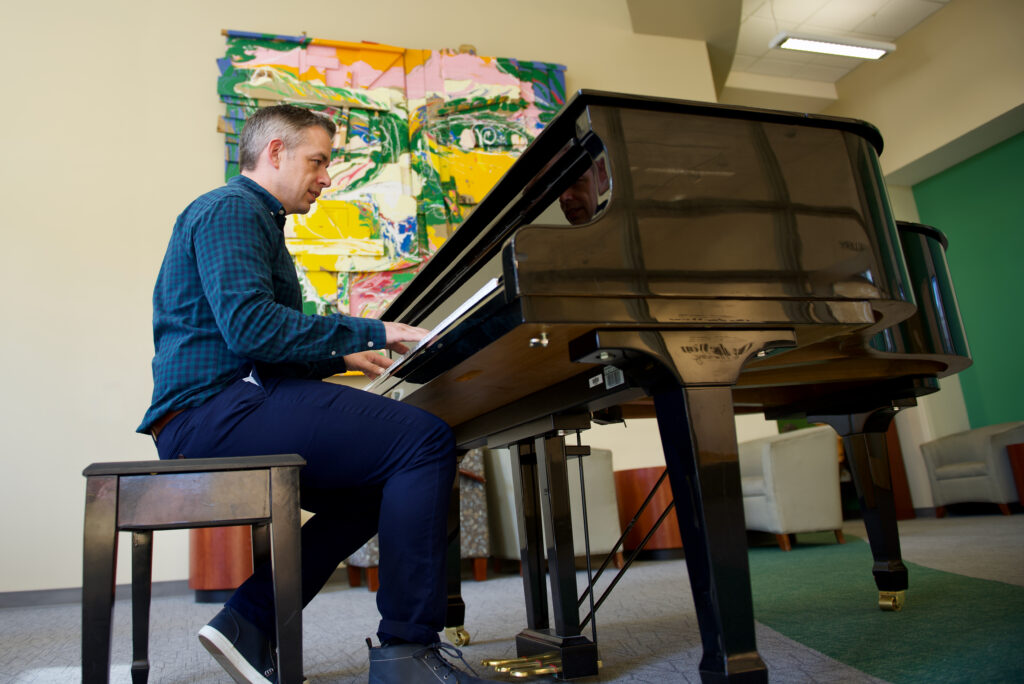
As a boy, Andrew Truman learned to play the piano, coaxing tunes from the instrument by playing the 88 black and white keys in specific combinations. Now, as a UNC Charlotte biochemist, the cell proteins he researches are reminiscent of those black and white keys, producing specific patterns depending on how they are combined.
“We like to think of Hsp70 as a piano,” Truman says, “with each phosphorylation being a key on that piano. Pressing the keys in combination – adding a specific pattern of phosphorylations – produces a particular song.” Phosphorylation occurs when a phosphate group is added to a molecule.
“This is a unique way of looking at Hsp70,” he elaborates. “Our current mission is to decipher the regulation and role of the chaperone code.”
“By understanding and manipulating the chaperone code, we expect to uncover the secret inner workings of the cell.”
— Andrew Truman
Cracking the chaperone code is no easy task, given the huge number of phosphorylations on Hsp70, with over 85 currently identified.
“Some are not easy to detect, and we don’t have a clear idea of what most of these modifications do or how they’re added or removed from the chaperone proteins,” he says. “That’s fascinating from a biological perspective generally. Chaperones are fundamental to life. On the other hand, we’re also interested in the connection between the chaperone code and human illnesses. We hope to generate new medicines that alter the code, stopping the chaperones from working in cancer cells, while enhancing their protein folding ability in neurodegenerative diseases like Alzheimer’s or Huntington’s.”


Members of Andrew Truman’s lab team are a tight-knit group. Truman consistently includes students and other lab team members as authors on research papers and presentations, often as the primary authors. (Note: Lab photo was taken pre-pandemic.)
Drawing From Diverse Fields
The lab’s research draws from the varied areas of protein biochemistry, molecular biology, quantitative proteomics (study of sets of proteins), systems biology, bacterial and yeast genetics, model structures, and cell culture technologies. The team, including graduate and undergraduate studies students, collaborates with colleagues from around the world and has published over 40 studies to share their research.
Truman works closely with Mehdi Mollapour and Dimitra Bourboulia of SUNY Upstate Medical University (Syracuse, NY) and other chaperone code pioneers to build a collaborative international community focused on the complex issue.
“In addition to Hsp70, there are similar kinds of modifications on all the chaperone machinery,” Truman says. “It’s a real galaxy of modifications. These modifications were originally identified as background noise in previous studies. Through our collaborations, we realized that there are hundreds of these modifications, and they’re dynamic and are critical to how all cells work.”
In 2020, the first virtual “International Symposium on The Chaperone Code,” organized by Truman, Mollapour and Bourboulia, drew over 300 attendees. They also host speakers monthly in an exciting virtual “chaperone code club” forum.
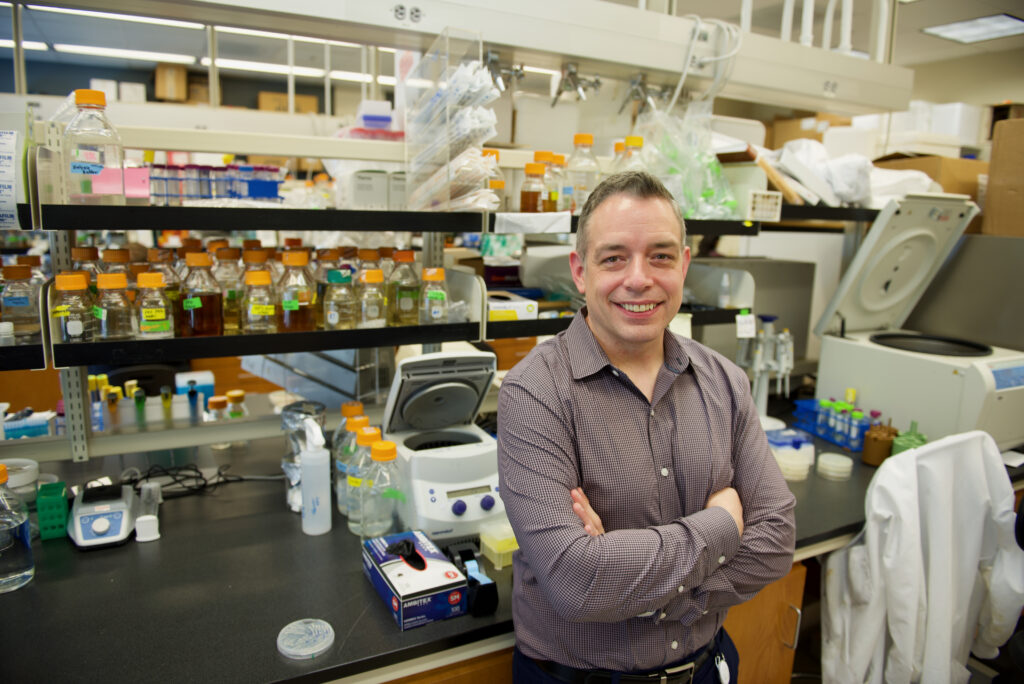
Closer to home, Truman is a member of the UNC Charlotte Genome Integrity Group, which studies how cells respond to DNA damage, alteration of which is a major hallmark of cancer. Core members include professors Christine Richardson, who is interim chair of the Department of Biological Sciences, Shan Yan, Kausik Chakrabarti and Junya Tomida. “Each member of the genome group works with different kinds of technology and organisms. We tightly collaborate with each other on several projects, and we’ve applied for grants together,” Truman says.
Truman joined the faculty at UNC Charlotte in August 2015. He had gained experience in postdoctoral positions at the University of Chicago, Boston University, Johns Hopkins Bloomberg School of Public Health, and Sheffield University, UK after earning a doctorate in biochemistry at University College London, UK. He was promoted to associate professor with tenure in July 2021. He is a fellow of the Cell Stress Society and is a senior editor for the scientific journals Cell Stress and Chaperones and Frontiers in Molecular Biosciences.
Words and Images: Lynn Roberson, CLAS Communications Director | Image of lab team members on the steps: Courtesy of Andrew Truman
Driving Innovation In Energy, Medicine, Defense, Communications, Center for Metamaterials Receives Third Round of NSF Funding
For over a decade, researchers and students in UNC Charlotte’s Center for Metamaterials have studied and created materials that can bend, absorb, transmit, and otherwise manipulate light and sound waves that pass through them.
“The capabilities of these engineered materials are enormous,” said Ish Aggarwal, center director. “These materials can suppress or amplify light and sound waves. Once developed, these materials could even hide an aircraft in the sky just as you would see in science fiction movies.”
Generally speaking, metamaterials are specially engineered materials with properties that differ substantially from those found in nature.
In recognition of innovative collaboration with industry and government partners in metamaterials research, the UNC Charlotte center has joined a select handful of Industry/University Collaborative Research Centers (I/UCRCs) nationwide to earn a third phase of National Science Foundation (NSF) funding. The NSF support for administering the center is expected to total $250,000 over the next five years.
Researchers, students, and industry and government collaborators in the UNC Charlotte center focus primarily on sensing, imaging, antennas and energy harvesting. Plans call for new research in medical and acoustic metamaterials.
The research considers a broad range of commercially relevant applications that can help address problems in renewable energy, transportation, avionics, consumer electronics, homeland security and defense, health, and medical technology, communications, and other areas. Several specific applications developed in the UNC Charlotte center have transitioned to industry.
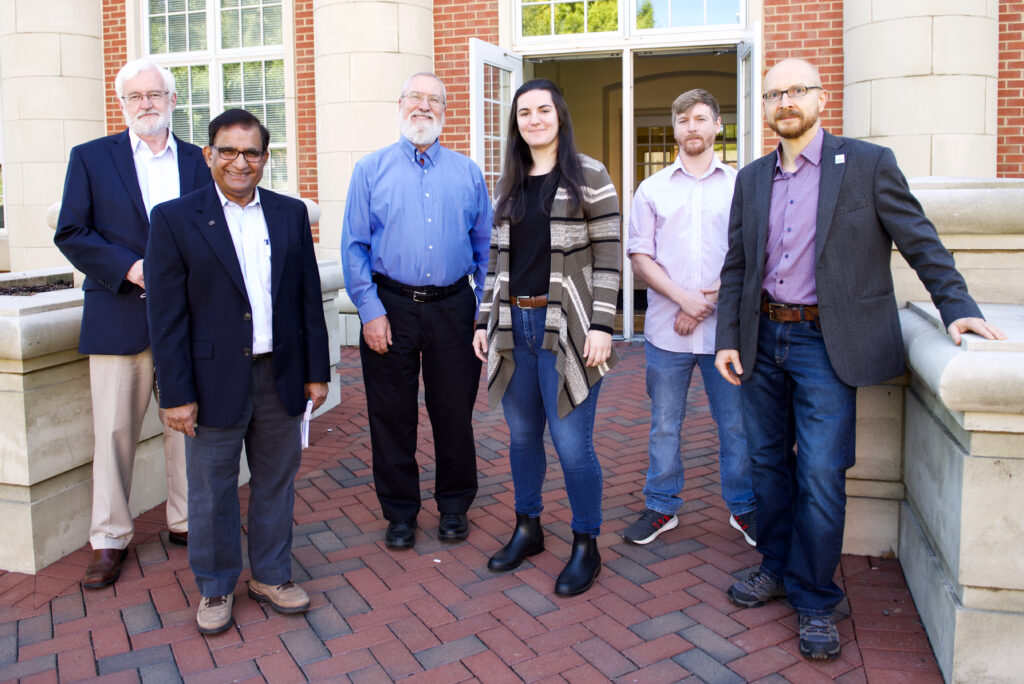
While considering the practical applications, the UNC Charlotte center also addresses foundational scientific questions related to the physical processes that occur when electromagnetic or mechanical waves interact with subwavelength-sized structures. A fundamental limitation of most metamaterials is that they are inherently narrowband, functional over a small range of frequencies. The challenge is to engineer material properties that are broadband, tunable, and able to be manufactured in a cost-effective way.
“The beauty of our program is that it takes advantage of the ingenuity and innovativeness of academia, combined with the engineering, fabrication, and implementation of industry,” Aggarwal said. Students and faculty at the University suggest the projects, and the collaborating industry and government partners select projects and fund the work.
The center receives strong support from industry and government partners through membership fees. The partners’ financial support typically goes toward student stipends and tuition, offering a valuable resource for the Optical Science and Engineering interdisciplinary doctoral program.

One of the doctoral students, Paige Stinson, who is currently an intern with center industry partner UC Conec with support from the National Science Foundation, has gained expertise and relationships through the center.
“The center has provided me with the resources I need to accomplish the fundamental research goals of my Ph.D. while allowing the creative flexibility to simultaneously explore my interests and present new ideas,” Stinson said. “The cleanroom facilities which we have access to in the center are the foundation of my current research, particularly our Nanoscribe. Perhaps even more impactful, the center has allowed me to have a direct relationship with not only fellow researchers in the center but also with industry leading companies and government research labs.” A Nanoscribe is a 3D printer for objects with dimensions of one billionth of a meter.
Graduate and undergraduate students conduct research with guidance from faculty and center members. Students, many of whom come from under-represented groups in science and engineering, are prepared as highly skilled scientists and engineers. One of the biggest advantages for the partners is the ability to assess and hire students working with the center.
Another doctoral student, Micheal McLamb, has learned to focus his research to address real-world problems through direct interaction with center partners.
“These collaborators follow your work through the years and know your name,” McLamb said. “Student involvement with the Center enhances the desirability and chances of employers hiring a student pending graduation. Currently, I conduct research on reflective and absorbing metamaterials. I am collaborating with several scientists from Air Force Research Labs (AFRL) on a couple of projects involving these materials. This collaboration has also led to a paid internship with AFRL funded by the National Science Foundation.”
For these students and others, the collaborative research has led to co-authored publications, including in the journals Optics Letters, Thin Solid Films and Plasmonics.
“It is largely because of the hard work of our faculty directing this center, both now and in the past, and because of our relationships with our partners, that we have been able to achieve this milestone with the continued NSF support,” said Glenn Boreman, chair of the Department of Physics and Optical Science. “We have a very talented set of faculty participants from the College of Liberal Arts & Sciences and the Lee College of Engineering in particular.”
Leadership in the center in addition to Aggarwal includes co-director Tino Hofmann and founding director Michael Fiddy, all faculty in the Department of Physics and Optical Science in the College of Liberal Arts & Sciences. Also partnering with UNC Charlotte is Clarkson University as an affiliated site.
Words and Photos: Lynn Roberson | Graphics: Ashley Plyler | Top Image: Doctoral students Paige Stinson (seated) and Micheal McLamb conduct research in the cleanroom.